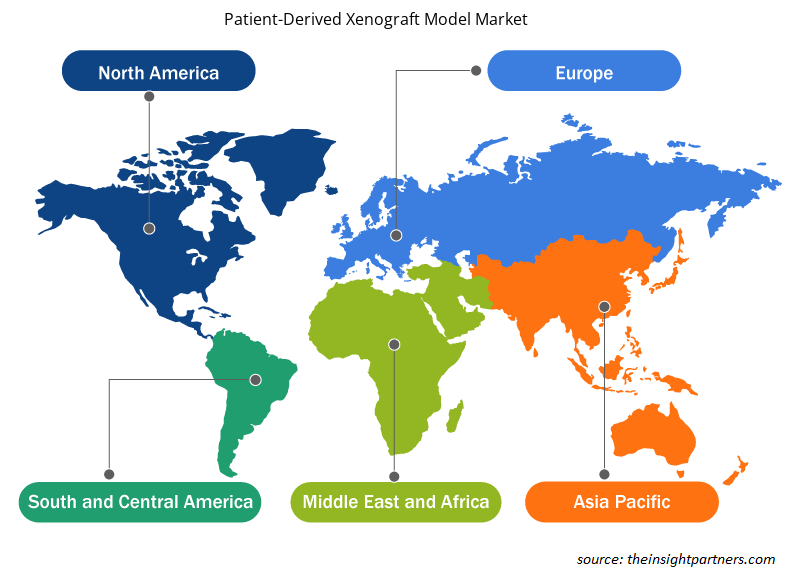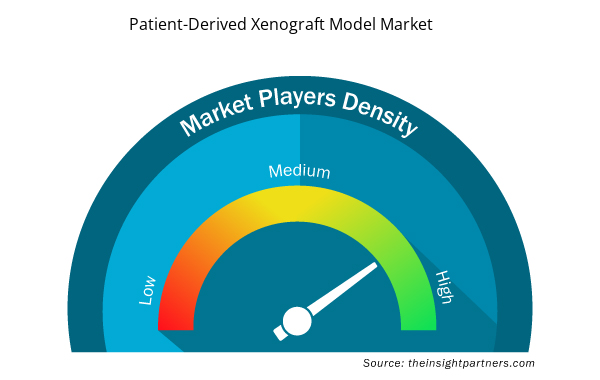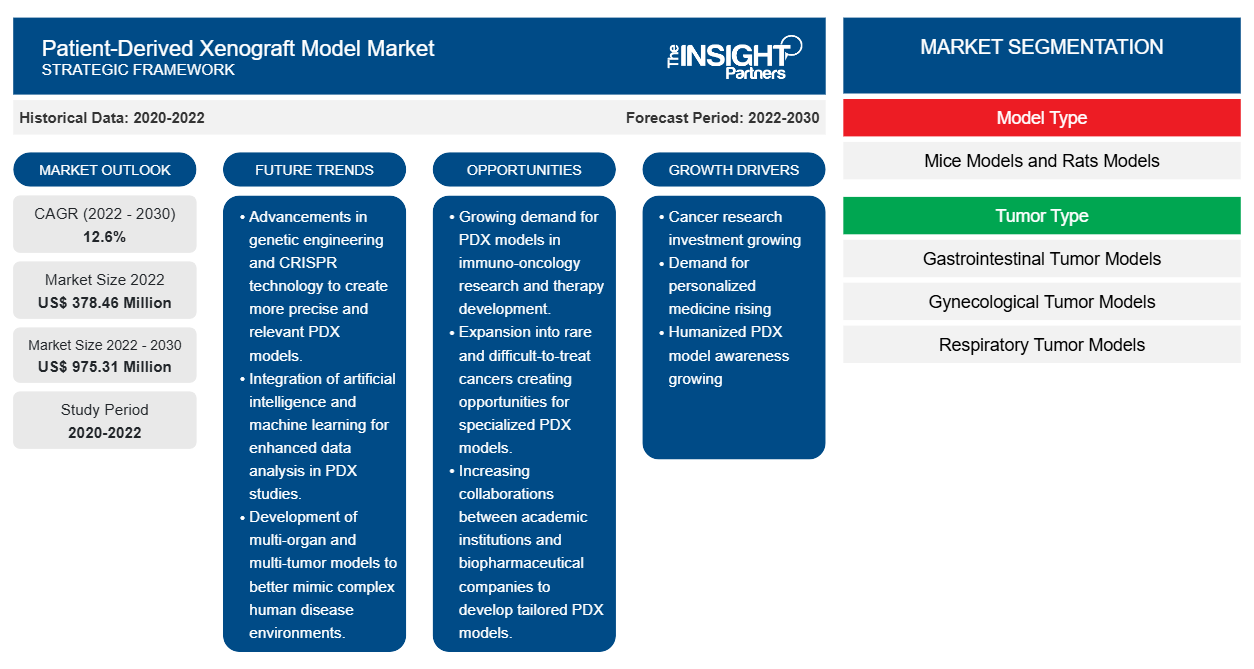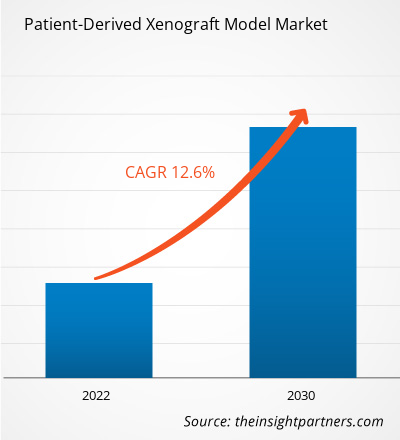[研究报告] 患者来源异种移植模型市场规模预计将从 2022 年的 3.7846 亿美元增长到 2030 年的 9.7531 亿美元;预计 2022-2030 年期间的复合年增长率为 12.6%。
市场洞察和分析师观点:
患者来源异种移植 (PDX) 模型是指通过将患者肿瘤组织直接植入免疫缺陷小鼠而创建的实验室模型。这些模型用于临床前研究,以研究肿瘤的行为并评估潜在疗法的疗效。预计未来十年市场将表现出色。随着对癌症研究的投资增加和对个性化医疗的需求不断增长,PDX 模型的采用可能会大幅增加。随着药物开发商努力提高临床成功率,PDX 模型因其能够模拟人类肿瘤行为和适合治疗反应预测研究而成为一种有价值的工具,这有利于患者来源异种移植模型市场的增长
增长动力:
现在,免疫功能低下的小鼠会被移植骨髓或外周血细胞以及患者的肿瘤植入物,以创建人源化异种移植模型。人源化模型可用于研究异种免疫细胞在整体抗癌免疫中的作用。人源化模型也有助于免疫治疗药物的开发。然而,在人源化小鼠模型中,存在移植物抗宿主病的风险,这可能会妨碍基质-肿瘤相互作用评估研究的结果。这些相互作用对患者的肿瘤生长和进展至关重要。植入 PDX 的人源化模型为肿瘤学研究提供了一种有前途的方法,可以更好地了解人类肿瘤并加速个性化治疗的发展。PDX 模型具有许多优势,包括描述患者的肿瘤微环境及其多样性、检测治疗靶点、确定开发个性化疗法的潜力以及与完整的人体免疫系统相互作用。人源化患者来源异种移植模型有助于克服人源化小鼠模型的缺点,并且市场需求不断增长。例如,Champions Oncology 已从原发期或转移期的不同患者中开发出 1,500 多种不同的肿瘤模型。因此,人们对人源化 PDX 模型益处的认识不断提高,推动了预测期内患者来源异种移植模型市场的增长。
此外,患者来源异种移植模型市场趋势包括下一代 PDX 技术的开发和正在进行的药物开发研究。
定制此报告以满足您的需求
您可以免费定制任何报告,包括本报告的部分内容、国家级分析、Excel 数据包,以及为初创企业和大学提供优惠和折扣
- 获取此报告的关键市场趋势。这个免费样品将包括数据分析,从市场趋势到估计和预测。
报告细分和范围:
患者来源异种移植模型市场分析已通过考虑以下部分进行:模型类型、肿瘤类型、应用、最终用户和地理位置。根据模型类型,市场分为小鼠模型和大鼠模型。就肿瘤类型而言,患者来源异种移植模型市场分为胃肠道肿瘤模型、妇科肿瘤模型、呼吸道肿瘤模型和其他肿瘤模型。根据应用,市场细分为临床前药物开发、生物标志物分析、转化研究和生物银行。根据最终用户,市场细分为制药和生物技术公司、学术和政府研究机构以及合同研究组织。
患者来源异种移植模型市场报告的范围涵盖北美(美国、加拿大和墨西哥)、欧洲(法国、德国、英国、西班牙、意大利和欧洲其他地区)、亚太地区(中国、日本、印度、韩国、澳大利亚和亚太其他地区)、中东和非洲(沙特阿拉伯、阿联酋、南非和中东和非洲其他地区)以及南美洲和中美洲(巴西、阿根廷和南美洲和中美洲其他地区)。
节段分析:
按照模型类型,患者来源的异种移植模型市场分为小鼠模型和大鼠模型。小鼠模型部分在 2022 年占据了相当大的市场份额。预计在 2022-2030 年期间,市场复合年增长率将更高。
根据肿瘤类型,市场细分为胃肠道肿瘤模型、呼吸道肿瘤模型、妇科肿瘤模型和其他肿瘤模型。2022 年,其他肿瘤模型细分市场占据了相当大的市场份额,预计在 2022-2030 年期间将实现最快的复合年增长率。
根据应用,市场分为临床前药物开发、生物标志物分析、转化研究和生物库。临床前药物开发领域在 2022 年占据了患者来源异种移植模型市场的很大份额。预计该领域在 2022-2030 年期间的复合年增长率最高。
根据最终用户,市场分为制药和生物技术公司、合同研究组织以及学术和政府研究机构。学术和政府研究机构部分在 2022 年占据了患者来源异种移植模型市场的很大份额。预计在 2022-2030 年期间将实现最高的复合年增长率。
区域分析:
根据地理位置,患者来源的异种移植模型市场报告主要分为北美、欧洲、亚太地区、南美和中美以及中东和非洲。2022 年,北美占据了相当大的市场份额。2022 年,美国在该地区占据了最大的市场份额。北美市场的增长归因于现代医疗基础设施的可用性、主要市场参与者的强大存在、癌症病例数量的增加以及政府和私营部门的投资增加。根据疾病控制和预防中心的数据,2020 年,美国女性中报告了约 239,612 例乳腺癌新病例,而约 42,273 例死于该疾病。每 100,000 名女性中,有 119 例新发乳腺癌病例报告,其中近 19 例死亡。根据乳腺癌组织的乳腺癌统计数据,大约每 8 名女性中就有 1 名(即 12%)在其一生中会患上侵袭性乳腺癌。此外,由于乳腺癌是加拿大女性中最常见的癌症,也是癌症死亡的第二大原因,因此对高效诊断方案的需求很高。根据加拿大癌症协会的数据,2022 年该国约有 28,600 名女性被诊断出患有乳腺癌,占女性新发癌症病例总数的约 25%。随着癌症病例的增加,开发合适治疗方法的需求也随之增加,这推动了患者来源异种移植模型市场的增长。
根据 Oncoimmunology 于 2022 年 4 月发表的一篇文章,研究人员使用多样性杂交 (DO) 和协作杂交 (CC) 小鼠模型来研究免疫检查点抑制剂对各种肿瘤的效果。在这项研究中,研究人员从杰克逊实验室购买了 DO 小鼠模型,从北卡罗来纳大学的系统遗传学核心设施购买了 CC 小鼠。因此,日益增长的研究和小鼠模型在抗癌药物发现中的应用推动了该地区患者来源的异种移植模型市场的增长。
患者来源的异种移植模型
患者来源异种移植模型市场区域洞察
Insight Partners 的分析师已详尽解释了预测期内影响患者来源异种移植模型市场的区域趋势和因素。本节还讨论了患者来源异种移植模型市场的各个部分和地理位置,包括北美、欧洲、亚太地区、中东和非洲以及南美和中美洲。

- 获取患者来源异种移植模型市场的区域特定数据
患者来源的异种移植模型市场报告范围
| 报告属性 | 细节 |
|---|---|
| 2022 年市场规模 | 3.7846亿美元 |
| 2030 年的市场规模 | 9.7531亿美元 |
| 全球复合年增长率(2022 - 2030 年) | 12.6% |
| 史料 | 2020-2022 |
| 预测期 | 2022-2030 |
| 涵盖的领域 | 按模型类型
|
| 覆盖地区和国家 | 北美
|
| 市场领导者和主要公司简介 |
|
患者来源的异种移植模型市场参与者密度:了解其对业务动态的影响
患者来源异种移植模型市场正在快速增长,这得益于终端用户需求的不断增长,而这些需求又源于消费者偏好的不断变化、技术进步以及对产品优势的认识不断提高等因素。随着需求的增加,企业正在扩大其产品范围,进行创新以满足消费者的需求,并利用新兴趋势,从而进一步推动市场增长。
市场参与者密度是指在特定市场或行业内运营的企业或公司的分布情况。它表明在给定市场空间中,相对于其规模或总市场价值,有多少竞争对手(市场参与者)存在。
在患者来源异种移植模型市场运营的主要公司有:
- 冠军肿瘤学公司
- 查尔斯河实验室公司
- 冠生生物科技公司
- 欧洲专利局柏林书店有限公司
- 赫拉生物实验室
免责声明:上面列出的公司没有按照任何特定顺序排列。

- 获取患者来源异种移植模型市场顶级关键参与者概览
行业发展和未来机遇:
- 2022 年 7 月,GemPharmatech 与 Charles River Laboratories 达成战略许可协议。该合作伙伴关系涉及 GemPharmatech 下一代 NOD CRISPR Prkdc Il2r gamma (NCG) 小鼠品系在北美的独家经销权。
- 2021 年 11 月,Inotiv Inc. 完成对全球领先的研究模型和服务提供商 Envigo RMS Holding Corp. 的收购。
竞争格局和重点公司:
患者来源的异种移植模型市场预测可以帮助利益相关者规划其增长战略。Champions Oncology Inc.、Charles River Laboratories Inc.、Crown Bioscience Inc.、EPO Berlin-Buch GmbH、Hera BioLabs、Horizon Discovery Group plc、Oncodesign、Pharmatest Services Ltd、Xentech SAS 和 JSR Corporation 是该市场的主要参与者。市场参与者专注于推出新的高科技产品、改进现有产品和扩大地域范围,以满足全球日益增长的消费者需求。
- 历史分析(2 年)、基准年、预测(7 年)及复合年增长率
- PEST 和 SWOT 分析
- 市场规模价值/数量 - 全球、区域、国家
- 行业和竞争格局
- Excel 数据集



Report Coverage
Revenue forecast, Company Analysis, Industry landscape, Growth factors, and Trends

Segment Covered
This text is related
to segments covered.

Regional Scope
North America, Europe, Asia Pacific, Middle East & Africa, South & Central America

Country Scope
This text is related
to country scope.
常见问题
The factors driving the growth of the patient-derived xenograft model market include the growing awareness of the advantages of humanized PDX models and the rising demand for personalized medicine. However, significant operational costs associated with the PDX model hampers the growth of the patient-derived xenograft model market.
The patient-derived xenograft (PDX) model refers to laboratory models that are created by implanting patient tumor tissues directly into immunodeficient mice. These models are used in preclinical research to study the behavior of tumors and evaluate the efficacy of potential therapies.
The global patient-derived xenograft model market is segmented based on model type, tumor type, application, and end user. The patient-derived xenograft model market, by model type, is categorized into mice models and rats models. The mice models segment held a significant share of the market in 2022 and is expected to register a higher CAGR in the market during 2022–2030.
The patient-derived xenograft model market was valued at US$ 378.46 million in 2022.
The patient-derived xenograft model market is expected to be valued at US$ 975.31 million in 2030.
The patient-derived xenograft model market majorly consists of the players, including Champions Oncology Inc., Charles River Laboratories Inc., Crown Bioscience Inc., EPO Berlin-Buch GmbH, Hera BioLabs, Horizon Discovery Group plc, Oncodesign, Pharmatest Services Ltd, Xentech SAS, and JSR Corporation.
Trends and growth analysis reports related to Life Sciences : READ MORE..
The List of Companies - Patient-Derived Xenograft Model Market
- Champions Oncology Inc.
- Charles River Laboratories Inc.
- Crown Bioscience Inc.
- EPO Berlin-Buch GmbH
- Hera BioLabs
- Horizon Discovery Group plc
- Oncodesign
- Pharmatest Services Ltd
- Xentech SAS
- JSR Corporation.
The Insight Partners performs research in 4 major stages: Data Collection & Secondary Research, Primary Research, Data Analysis and Data Triangulation & Final Review.
- Data Collection and Secondary Research:
As a market research and consulting firm operating from a decade, we have published and advised several client across the globe. First step for any study will start with an assessment of currently available data and insights from existing reports. Further, historical and current market information is collected from Investor Presentations, Annual Reports, SEC Filings, etc., and other information related to company’s performance and market positioning are gathered from Paid Databases (Factiva, Hoovers, and Reuters) and various other publications available in public domain.
Several associations trade associates, technical forums, institutes, societies and organization are accessed to gain technical as well as market related insights through their publications such as research papers, blogs and press releases related to the studies are referred to get cues about the market. Further, white papers, journals, magazines, and other news articles published in last 3 years are scrutinized and analyzed to understand the current market trends.
- Primary Research:
The primarily interview analysis comprise of data obtained from industry participants interview and answers to survey questions gathered by in-house primary team.
For primary research, interviews are conducted with industry experts/CEOs/Marketing Managers/VPs/Subject Matter Experts from both demand and supply side to get a 360-degree view of the market. The primary team conducts several interviews based on the complexity of the markets to understand the various market trends and dynamics which makes research more credible and precise.
A typical research interview fulfils the following functions:
- Provides first-hand information on the market size, market trends, growth trends, competitive landscape, and outlook
- Validates and strengthens in-house secondary research findings
- Develops the analysis team’s expertise and market understanding
Primary research involves email interactions and telephone interviews for each market, category, segment, and sub-segment across geographies. The participants who typically take part in such a process include, but are not limited to:
- Industry participants: VPs, business development managers, market intelligence managers and national sales managers
- Outside experts: Valuation experts, research analysts and key opinion leaders specializing in the electronics and semiconductor industry.
Below is the breakup of our primary respondents by company, designation, and region:

Once we receive the confirmation from primary research sources or primary respondents, we finalize the base year market estimation and forecast the data as per the macroeconomic and microeconomic factors assessed during data collection.
- Data Analysis:
Once data is validated through both secondary as well as primary respondents, we finalize the market estimations by hypothesis formulation and factor analysis at regional and country level.
- Macro-Economic Factor Analysis:
We analyse macroeconomic indicators such the gross domestic product (GDP), increase in the demand for goods and services across industries, technological advancement, regional economic growth, governmental policies, the influence of COVID-19, PEST analysis, and other aspects. This analysis aids in setting benchmarks for various nations/regions and approximating market splits. Additionally, the general trend of the aforementioned components aid in determining the market's development possibilities.
- Country Level Data:
Various factors that are especially aligned to the country are taken into account to determine the market size for a certain area and country, including the presence of vendors, such as headquarters and offices, the country's GDP, demand patterns, and industry growth. To comprehend the market dynamics for the nation, a number of growth variables, inhibitors, application areas, and current market trends are researched. The aforementioned elements aid in determining the country's overall market's growth potential.
- Company Profile:
The “Table of Contents” is formulated by listing and analyzing more than 25 - 30 companies operating in the market ecosystem across geographies. However, we profile only 10 companies as a standard practice in our syndicate reports. These 10 companies comprise leading, emerging, and regional players. Nonetheless, our analysis is not restricted to the 10 listed companies, we also analyze other companies present in the market to develop a holistic view and understand the prevailing trends. The “Company Profiles” section in the report covers key facts, business description, products & services, financial information, SWOT analysis, and key developments. The financial information presented is extracted from the annual reports and official documents of the publicly listed companies. Upon collecting the information for the sections of respective companies, we verify them via various primary sources and then compile the data in respective company profiles. The company level information helps us in deriving the base number as well as in forecasting the market size.
- Developing Base Number:
Aggregation of sales statistics (2020-2022) and macro-economic factor, and other secondary and primary research insights are utilized to arrive at base number and related market shares for 2022. The data gaps are identified in this step and relevant market data is analyzed, collected from paid primary interviews or databases. On finalizing the base year market size, forecasts are developed on the basis of macro-economic, industry and market growth factors and company level analysis.
- Data Triangulation and Final Review:
The market findings and base year market size calculations are validated from supply as well as demand side. Demand side validations are based on macro-economic factor analysis and benchmarks for respective regions and countries. In case of supply side validations, revenues of major companies are estimated (in case not available) based on industry benchmark, approximate number of employees, product portfolio, and primary interviews revenues are gathered. Further revenue from target product/service segment is assessed to avoid overshooting of market statistics. In case of heavy deviations between supply and demand side values, all thes steps are repeated to achieve synchronization.
We follow an iterative model, wherein we share our research findings with Subject Matter Experts (SME’s) and Key Opinion Leaders (KOLs) until consensus view of the market is not formulated – this model negates any drastic deviation in the opinions of experts. Only validated and universally acceptable research findings are quoted in our reports.
We have important check points that we use to validate our research findings – which we call – data triangulation, where we validate the information, we generate from secondary sources with primary interviews and then we re-validate with our internal data bases and Subject matter experts. This comprehensive model enables us to deliver high quality, reliable data in shortest possible time.


 获取此报告的免费样本
获取此报告的免费样本